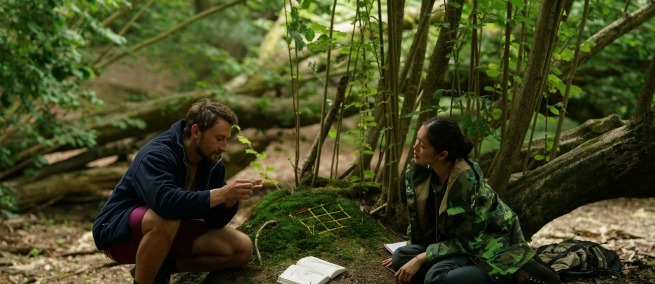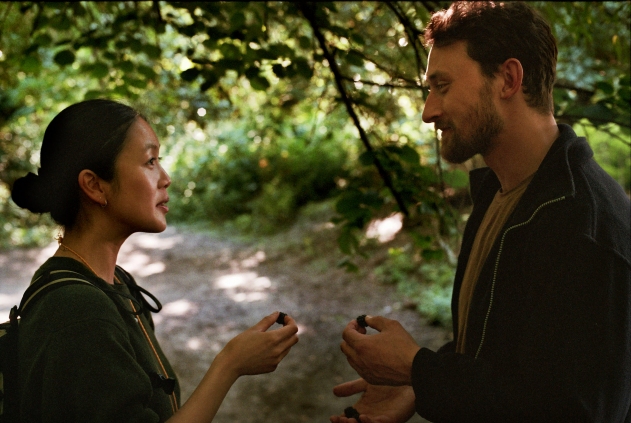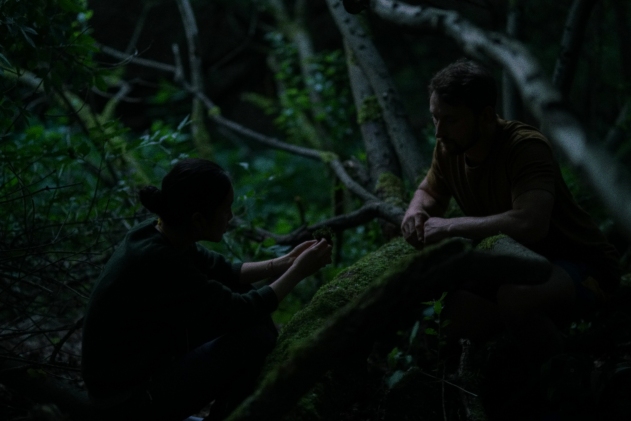
Bas Devos’s enchanting film HERE, which won both the Encounters Award and the FIPRESCI Prize at the 2023 Berlin International Film Festival, is now being released into theaters by Cinema Guild. The film follows Stefan (Stefan Gota), a Romanian construction worker considering leaving his home in Brussels, whose perception of the city is transformed by an encounter with Shuxiu (Liyo Gong), a Chinese-Belgian bryologist who is studying local moss. We spoke with writer/director Bas Devos about his interest in most, developing a character who is a bryologist, and the film’s unique cinematic language.
Science & Film: HERE has such a specific feel that I think comes in part from the landscapes you bring into focus. Where did you film, and how did that figure into the narrative for you?
Bas Devos: Very often locations are not necessarily starting points, but I really like to write about places that I know and people that I know—people who I love and places that I love. Very quickly in the writing process, I started to think about where am I going to film? What places would I like to film? I think this is also something that is somewhat overlooked in filmmaking, this desire to film specific things, specific places, as a reason to make films.
Because I go about my daily life so much on foot and by bike, and so little by car, because I can't drive a car and I depend on other people, I really tend to also focus on my close surroundings. A lot of the locations you see in the film are within walking distance of where I live, which is both embarrassing, but also, for me, very pleasant. It's just really nice to film things you know. The main locations are our center of Brussels, the city where I live. And then there's a region between Brussels and the nearest next town, which in the film is referred to, because that's where Stefan has to go pick up his car. There's a train track between Brussels and this town, and alongside this train track, where I filmed most of the film.
S&F: I feel like there's an unexpected lushness of the environment there.
BD: Yeah, I mean, there are a lot of these parks in Brussels and there's quite a lot of green and also some of these strangely unkept zones that are halfway between swampy areas and park. This particular zone in the film is a somewhat toxic place because it's directly next to the train tracks and they use a lot of chemicals to keep the green away from the train tracks because of all kinds of possible dangers of overgrown tracks. Water runs down and it ends up often in these places directly next to the train tracks, so even though the ground is really disturbed, and it's a very wounded place, there is still so much resilient green. This is what attracted me a lot. It's this strange place where the wildness of nature and just people walking dogs meet. It also has a plateau from which you can see quite far. So yeah, it's a place I know very well, it's where I often go for walks out on my own, so it felt very logical that this would be part of the story.

Liyo Gong and Stefan Gota in HERE. Courtesy of Cinema Guild.
S&F: It seems to me like that word resiliency is key to the characters and maybe what they get from being in that environment.
BD: Yeah, with all the green it's like the city can't hold it back, moss is everywhere. This potential is something that I wanted to somehow tap into and make part of this film.
S&F: You have a character who is a bryologist, how did you find out about this profession, and did you work with anyone on the film who helped with those specifics?
BD: I was reading this book by Anna Tsing called The Mushroom at the End of the World, which I thought was so amazing. I think it must have been there that I read about Robin Wall Kimmerer, a bryologist, scientist, teacher, and writer in such a pleasant and beautiful way about different kinds of knowledge and different kinds of intelligences. She wrote a small book called Gathering Moss, which is such a nice introduction for people who are not scientific, like me, into not only the scientific worth of moss but also the strange and intricate link between moss and us being here today. She eloquently explains how moss is our direct forefather, because it was the first plant to grow on land, and so the creator of oxygen through photosynthesis. I thought that was already so amazing that this tiny, tiny plant is our kin. I just remember reading this and feeling that she woke this desire in me to see moss, and then I was like, bryologist, there must be more than one. It turns out there are some in Belgium, but I happened to meet most likely the kindest of them all, a man named Geert Raeymaekers. I contacted him, I explained that I wrote about moss, but had no clue whether it made much sense. I wanted to also see moss for myself the way that a bryologist would see it, so he took me to the location where we shot the film. We looked at moss together, and I had this strange moment where I went, like, ah, this is so nice. If only a fifth of what I'm feeling now can be transmitted through the film, that would already be amazing. For me, it was something transformative to feel intimate with a plant, in a way, and to really understand a little bit more how we are just humans and how there is so much more intelligence that we discard.
S&F: How did you work with your cinematographer on the shifting perspective we see in the film?
BD: We have a longer history, it's not the first film we have done together. There is relatively little preparation, we think more in broad strokes. One of the really clear broad strokes for me was that this film would be about zooming in without actually making a zoom shot. [It would be about] working in different scales, coming closer and closer—the way that we open with a construction site, and then only after a couple of scenes, we find the main character and slowly also move into the even smaller world of the mosses. So that was a guideline.
We of course knew that to film such a small plant you need specific kinds of lenses, you can't just film it with any lens, you need macro lenses that are capable of catching such a such a near object. So, there was of course some technical preparation, but mainly, we just went out and we looked and tried to see a little bit in the way that I saw when I went out for the first time. We were trying to find a way of bringing this nature, which normally works as sort of background, but to bring that to the foreground and to make it really present in the film, not just nice images. We don't care for nice images, we care a lot about the right image. This was a more horizontal way of filmmaking in which everything has the same worth, so that not only the characters and not only the dialogue, or not only the plot, but also the sound design and the cinematography, and the background would become as important. This was a goal, but one that made me very unsure, like, can we do it?

Liyo Gong and Stefan Gota in HERE. Courtesy of Cinema Guild.
S&F: I'm curious if in any of your future projects you want to carry these ideas or modes of working forward?
BD: It's so hard to talk about future projects because I feel that I'm in this stage where everything is still very open and can still change and take many different directions. But I think there is a way of seeing that I have been slowly developing not only in the last film, but also with the films I made before, that always made me a little bit unsure. But in a way, this film reassured me in that kind of way of seeing, in that more horizontal filmmaking. And so, hard to say, but I think it would be for me difficult now not to continue on this path of looking at the world as a place where we're man is only man. That's a lot, that's amazing, but there is so much more. And to continue thinking about narratives that speak about connection, and collaboration, instead of conflict. I think there is a lot to gain, and I think there are a lot of stories untold. Of course, I'm not the only filmmaker thinking that way. But still, it feels somewhat like an uphill battle when I see what kind of films get traction, and what nice films sometimes disappear through the cracks.
♦
TOPICS